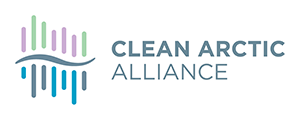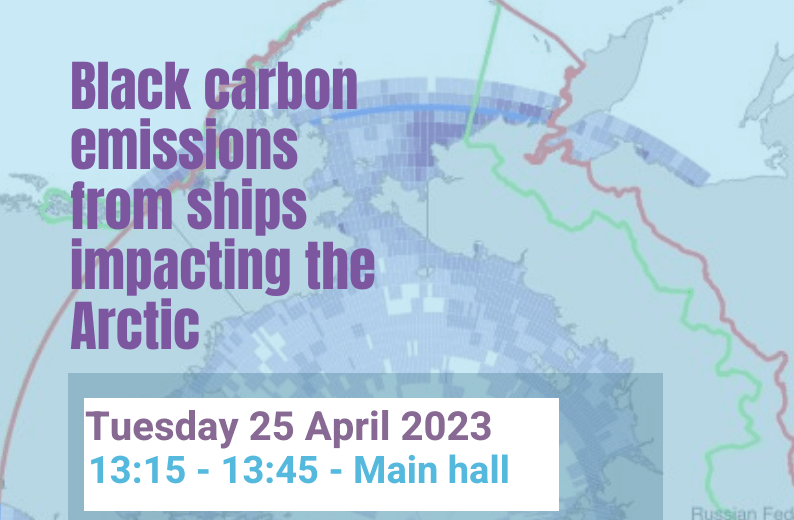
As new environmental priorities fill the agenda of the Arctic Council under Norway’s leadership, the Clean Arctic Alliance and one of our member organisations, Bellona, met last week with its chair, Morten Høgland, to discuss battling climate change in the earth’s most vulnerable and rapidly heating region. This article was first published on the Bellona website.
Reducing ongoing pollution from black carbon, carving out green shipping corridors, using cleaner shipping fuels and pursuing an overall zero-emissions policy were among the priorities for Sigurd Enge, Bellona’s senior shipping and Arctic, during the meeting, which took place on the sidelines of the Arctic Frontiers conference in Tromsø.
Enge was joined in the meeting with Høglund by Dr Sian Prior, lead advisor of the Clean Arctic Alliance, of which Bellona and a number of other international environmental groups, are members. Together, the organizations have campaigned for new Arctic emissions targets for black carbon, a particularly potent pollutant that accelerates Arctic melt.
“Black carbon emissions from ships have a particularly damaging impact on snow and ice in the Arctic and we are conscious that the Norwegian Chairship have made it one of their priorities for progress and action,” said Prior.
She emphasised that Council members must work to reach new black carbon emissions targets. While nations are on track to reduce emissions by 25-30% from all sectors by 2025, based on 2013 levels, shipping emissions have doubled during the same time.
“This is because currently there is no global or Arctic regulation of ship emissions of black carbon,” she continued. “Plus shipping in the Arctic is increasing — up 25% between 2013 and 2019 — and ships are spending longer at sea in the Arctic (75% increase in the same period). A new ambitious target will update the existing target, but it will be important that shipping emissions are highlighted as a sector in need of urgent action.”
Enge said that, as a Norwegian environmental organization, it was impingement upon Bellona to advance these goals while the council’s two-year rotating presidency was in Norway’s hands.
In the meeting with Høglund, Enge said: “In the alternative energy sector there is a lack of knowledge about production potential, environmental impact, and the future need for alternative energy for the Arctic green shift, especially for shipping. Do the different alternative fuel types have a worse impact on the Arctic’s condition? One of the Arctic Council’s core tasks is to establish a common fact base for the Arctic nations’ challenges. Energy is a main driver for a fossil free Arctic shipping sector.”
Enge and Prior also said it was critical for the International Maritime Organization, the UN agency that regulates international shipping, to take action against black carbon and enforce fuel standards particularly in the Arctic.
“The IMO has spent over a decade prevaricating on action to reduce black carbon emissions from ships,” she said. “It has decided what black carbon is, it’s agreed to three different ways to measure emissions but apart from a voluntary resolution it has not yet agreed on any action which will reduce emissions.”
“An IMO regulation requiring cleaner fuels in the Arctic, enforcement of an Arctic fuel standard, and the creation of black carbon control areas would”, said Prior “form the backbone of such regulation.”
“A coordinated Arctic Council Member initiative at the IMO could achieve this, as the rest of the world should respect that the Arctic States know what is needed and achievable in the Arctic,” she added.
Black carbon is composed of small light-absorbing graphite particles produced by diesel engines such as those found on cargo ships and tankers that ply Arctic waterways, and they are a major cause of climate change. In the Arctic, the accrual of these emissions is visible as soot coats the polar icecap, absorbing rather than reflecting solar radiation.
Yet, that very melting has also caused a spike in maritime traffic through the Northern Sea Route — a 5600-kilometre navigation artery running along Russia’s Arctic coast — leading to yet more soot deposits on the polar ice cap. Unless an agreement is reached among Arctic nations to cap soot emission in shipping, the cycle will continue.
Soot is also distributed across the Arctic by jets, burning wood and forest and tundra fires – the last of which are an ever-increasing problem emanating from Russia each summer as increasingly hot and dry seasons foster long burning and geographically enormous forest fires, which emergency service workers there are finding increasing difficult to cope with.
For many years black carbon has been known to warm the atmosphere by absorbing sunlight and speeding the melting of ice and snow. Studies have shown that these soot emissions are a far larger contributor to global warming than has been thought, and reductions in these emissions would very quickly have a positive effect on slowing warming.
Norway assumed the two-year rotating chairship to the Council in May of last year. Before that, the eight-nation Council — comprised of Canada, Denmark, Finland, Iceland, Norway, the Russian Federation, Sweden, and the United States, who each have an Arctic coast — had effectively been frozen following Russian’s February 2022 invasion of Ukraine.
During that time, Russia held the Council’s rotating presidency of the organization. But a freeze in cooperation among Moscow and the other countries on the Council made agreement on an environmental agenda for the Arctic sphere a tough prospect. Research involving Russia on issues ranging from climate change to polar bears has been put on hold, and scientists lost access to important facilities in the Russian Arctic.
As for Russia’s continuing role in the Council, senior Norwegian officials told the Arctic-base news site High North, that Russia’s participation in the Council remains important.
“We are not the Arctic 7. We are 8. We are the Arctic” Solveig Rossebø, Norway’s current senior Arctic official, told the site. “Russia is, and has always been, a constructive member of the Council.”
The Arctic Council, which doesn’t deal with security issues but makes binding agreements on environmental protection and gives a voice to the Indigenous peoples of the polar region was one of the few settings where Western countries and Russia worked together closely.
In a recent open letter to the Arctic Council, Bellona and the Alliance requested that a concrete zero-emissions policy be established for Arctic shipping, and that all Arctic nations implement the IMO resolution that urges the use of distillate or cleaner alternative fuels in or near the Arctic on a voluntary basis.
The Alliance and Bellona also ask that the Arctic Council consider the Indigenous population in the Arctic and ensure that their way of life is protected through a reduction in soot emissions.
Made up of 22 not-for-profit organisations, the Clean Arctic Alliance campaigns to persuade governments to take action to protect the Arctic, its wildlife and its people.
Members include: The Altai Project, Alaska Wilderness League, Bellona, Clean Air Task Force, Ecology and Development Foundation ECODES, Environmental Investigation Agency, Friends of the Earth US, Global Choices, Green Global Future, Green Transition Denmark, Greenpeace, Iceland Nature Conservation Association, International Cryosphere Climate Initiative, Nature And Biodiversity Conservation Union, Ocean Conservancy, Pacific Environment, Seas At Risk, Surfrider Foundation Europe, Stand.Earth, Transport & Environment, WWF and Zero.
More more information visit https://www.cleanarctic.org/




